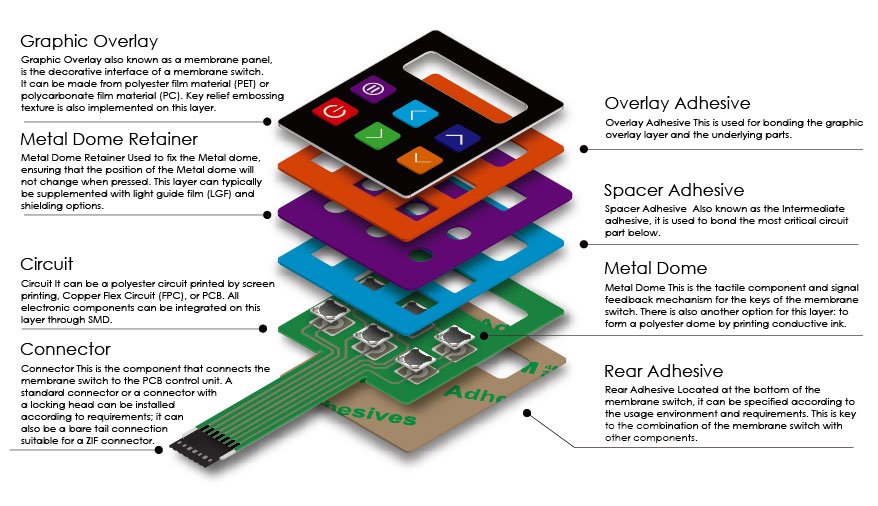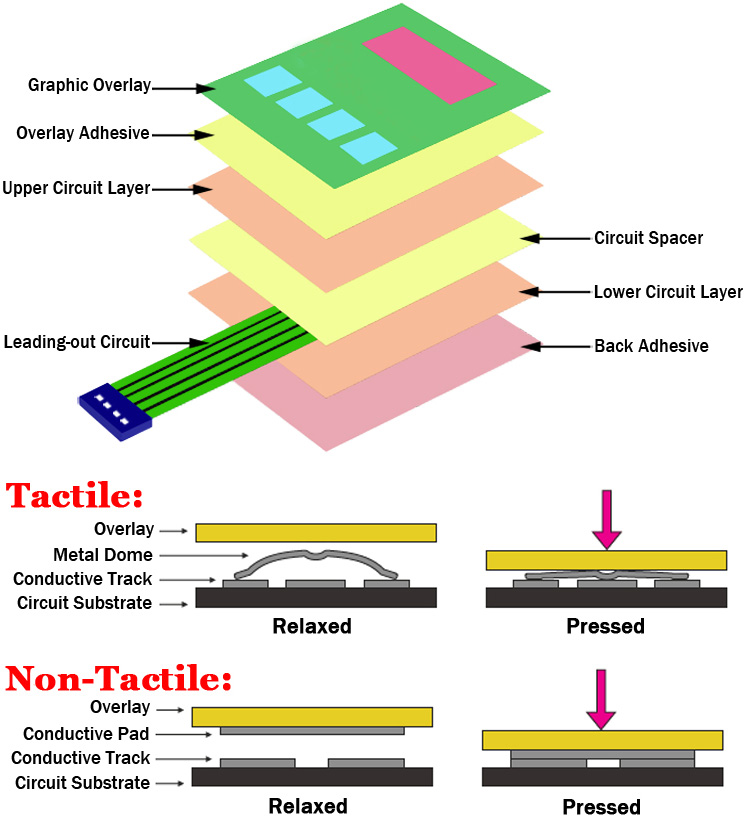The Manufacturing Refine Behind Membrane Layer Switch: What You Required to Know
The manufacturing procedure behind membrane switches over combines cautious layout, material selection, and top quality control. It begins with recognizing the complexities of membrane layer switch layout and advances through different stages, including product options and printing strategies. Each phase plays an essential duty in guaranteeing capability and sturdiness. However, the complexities of layer building and construction and the extensive screening standards may reveal insights that are not immediately noticeable. What exists past these foundational aspects?
Recognizing Membrane Switch Style
Membrane layer buttons might show up simple at first glimpse, their style entails detailed considerations that guarantee performance and sturdiness. The style process begins with a complete understanding of customer needs, consisting of the user interface's desired application and ecological variables. Ergonomics is a crucial element, as the format has to promote convenience of usage while ensuring that responsive responses satisfies individual expectations.Moreover, the layering of elements, such as graphic overlays, adhesive layers, and conductive traces, should be precisely engineered. membrane switch. This layered configuration not just affects the button's responsiveness however also impacts its longevity. Focus is provided to the securing methods employed to protect versus dampness and dirt, which could compromise efficiency. In addition, style considerations encompass aesthetics, where shade plans and visual clarity boost individual experience. Eventually, the design of membrane layer changes balances capability, individual experience, and durability, ensuring that they meet the needs of various applications effectively
Products Utilized in Membrane Switch Over Production
When picking products for membrane layer switch production, it is necessary to consider both efficiency and toughness. The main products include polyester and polycarbonate films, which supply versatility and toughness. These films are often covered with adhesive to ensure proper bonding to substratums. Conductive inks, generally composed of silver or carbon, are critical for producing electrical connections within the button, allowing for trusted operation.Additionally, a protective layer, such as a tough coat, is often related to enhance scrape resistance and long life. The choice of backing product, such as acrylic or foam, can considerably affect the button's tactile feel and total user experience. Furthermore, numerous ecological aspects, consisting of temperature and humidity, must lead material choice to ensure peak efficiency in specific applications. Ultimately, the best combination of products adds to the membrane layer switch's functionality and life expectancy, making notified options crucial for manufacturers.
The Printing Process: Creating Graphics and Text
The printing procedure in membrane layer button production plays a substantial duty in generating high-quality graphics and text. Various graphic style methods are utilized to guarantee visual appeal and functionality, while careful ink selection methods are important for sturdiness and performance. Understanding these elements is fundamental for achieving ideal outcomes in membrane layer button style.
Graphic Style Techniques
Graphic design techniques play a crucial duty in the printing procedure of membrane buttons, as they specify how graphics and message will eventually appear on the last product. Effective visuals style involves the critical use shades, font styles, and layouts to enhance readability and aesthetic appeal. Developers frequently make use of vector graphics for scalability, guaranteeing that photos stay sharp at various sizes. In addition, interest to comparison and alignment is essential, as it influences individual interaction and visual high quality. The consolidation of branding elements, such as logo designs, must be managed with treatment to keep brand name integrity. In general, thoughtful graphic layout methods contribute significantly to the performance and attractiveness of membrane buttons, impacting individual experience and item efficiency.
Ink Selection Techniques
Picking the suitable ink is necessary for achieving the desired aesthetic top quality and resilience in membrane layer button manufacturing. Numerous ink types are utilized, including solvent-based, water-based, and UV-curable inks. Each kind provides distinctive features, such as resistance, adaptability, and attachment to ecological factors. Solvent-based inks are frequently favored for their sturdiness and lively shades, while water-based inks are more environmentally friendly but may have limitations in adhesion. UV-curable inks provide rapid curing and durable efficiency. Furthermore, color matching methods ensure that the selected inks align with design requirements. Inevitably, the choice of ink should consider factors such as application method, substratum compatibility, and end-use demands to accomplish exceptional results in membrane switch graphics and message.
Layer Building And Construction and Setting Up

Product Choice Refine
A mindful selection of materials is vital in the production procedure of membrane layer switches, as it directly influences functionality and toughness. The key products made use of consist of polyester, polycarbonate, and numerous conductive inks. Polyester is often favored for its exceptional resistance to chemicals and abrasion, making it ideal for rough settings. Polycarbonate, on the various other hand, gives premium quality and influence resistance, which is beneficial for applications requiring presence and robustness. Conductive inks, generally composed of silver or carbon, are vital for creating reliable electric paths. In addition, the option of sticky products affects the general integrity of the switch - membrane switch. Reviewing variables such as ecological exposure, tactile responses, and visual needs overviews makers in choosing the best products for their details applications
Layer Bond Techniques
Sticking layers in membrane layer switch building is an important procedure that ensures performance and long life. Different adhesion strategies are utilized to secure suitable bonding between layers, which typically consist of using adhesives, heat, and stress. Pressure-sensitive adhesives (PSAs) are typically made use of for their simplicity of application and immediate bonding capacities. Furthermore, thermal bonding methods can be used, where heat is used to turn on sticky residential properties, protecting a solid bond. The choice of attachment technique greatly depends on the products entailed and the certain application requirements of the membrane button. Appropriate placement and uniform application of adhesives are vital to prevent flaws, securing the switch runs effectively throughout its designated life-span.
Quality Assurance Actions
Guaranteeing quality assurance throughout the layer construction and setting up of membrane layer switches is vital for keeping performance and dependability. This procedure typically includes a number of critical steps, consisting of thorough evaluations at each stage of manufacturing. Suppliers utilize advanced testing techniques, such as peel examinations and attachment assessments, to verify the integrity of layer bonds. Furthermore, aesthetic assessments are performed to recognize any defects in printing or material disparities. Environmental conditions, such as temperature and humidity, are very carefully kept an eye on to assure excellent healing and attachment. Moreover, normal calibration of tools aids keep specific production criteria. By implementing these quality control measures, suppliers can substantially lower the threat of product failure, guaranteeing that the last membrane switches meet the called for requirements and client expectations.
Testing and Quality Assurance Actions

Technologies in Membrane Layer Change Technology
As innovations in modern technology remain to evolve, membrane layer switches are taking advantage of cutting-edge advancements that enhance their capability and individual experience. One notable technology is the combination of capacitive touch technology, which permits for more receptive and user-friendly user interfaces. This change not only boosts aesthetics however also minimizes mechanical wear and tear, expanding the lifespan of the switches.Additionally, innovations in graphic overlay products have caused improved toughness and resistance to environmental aspects such as useful source moisture and UV light. These materials now supply boosted clarity and brightness, further elevating the visual appeal.Furthermore, the consolidation of smart innovation is changing membrane layer switches right into interactive control panels, enabling connectivity with IoT tools. This connectivity promotes a smooth user experience, paving the means for applications in numerous industries, from health care to customer electronics. Collectively, these advancements placement membrane changes as essential components in contemporary gadget layout.
Regularly Asked Questions
Exactly how Long Does the Membrane Layer Switch Over Production Refine Take?
The period of the membrane layer button production procedure can vary considerably. Elements such as complexity, products utilized, and manufacturing quantity impact timelines, with typical production ranging from a few days to a number of weeks for completion.
What Are the Typical Applications for Membrane Switches?
Membrane switches are typically used in different markets, consisting of vehicle controls, house devices, clinical gadgets, and customer electronics (membrane switch). Their adaptability and toughness make them excellent for applications calling for straightforward user interfaces and trustworthy performance in diverse environments
Can Membrane Layer Switches Over Be Personalized for Particular Requirements?

What Is the Lifespan of a Typical Membrane Layer Change?
The life-span of a normal membrane layer switch varies, however usually, it varies from 1 to 5 million cycles. Factors such as usage, atmosphere, and material high quality substantially affect resilience and general performance gradually.

Are Membrane Switches Environmentally Pleasant?
The ecological kindness of membrane changes varies. Some products made use of might not be recyclable, while others can be green. The general influence relies on producing products and techniques, requiring careful factor to consider throughout choice and disposal. The manufacturing procedure behind membrane layer changes combines careful layout, product choice, and quality control. It starts with comprehending the complexities of membrane her explanation button style and progresses via different stages, consisting of material selections and printing methods. When choosing materials for membrane switch production, it is crucial to ponder both efficiency and toughness. A cautious selection of products is see this essential in the production process of membrane layer buttons, as it directly affects capability and longevity. The option of bond technique mostly depends on the products included and the specific application requirements of the membrane switch.